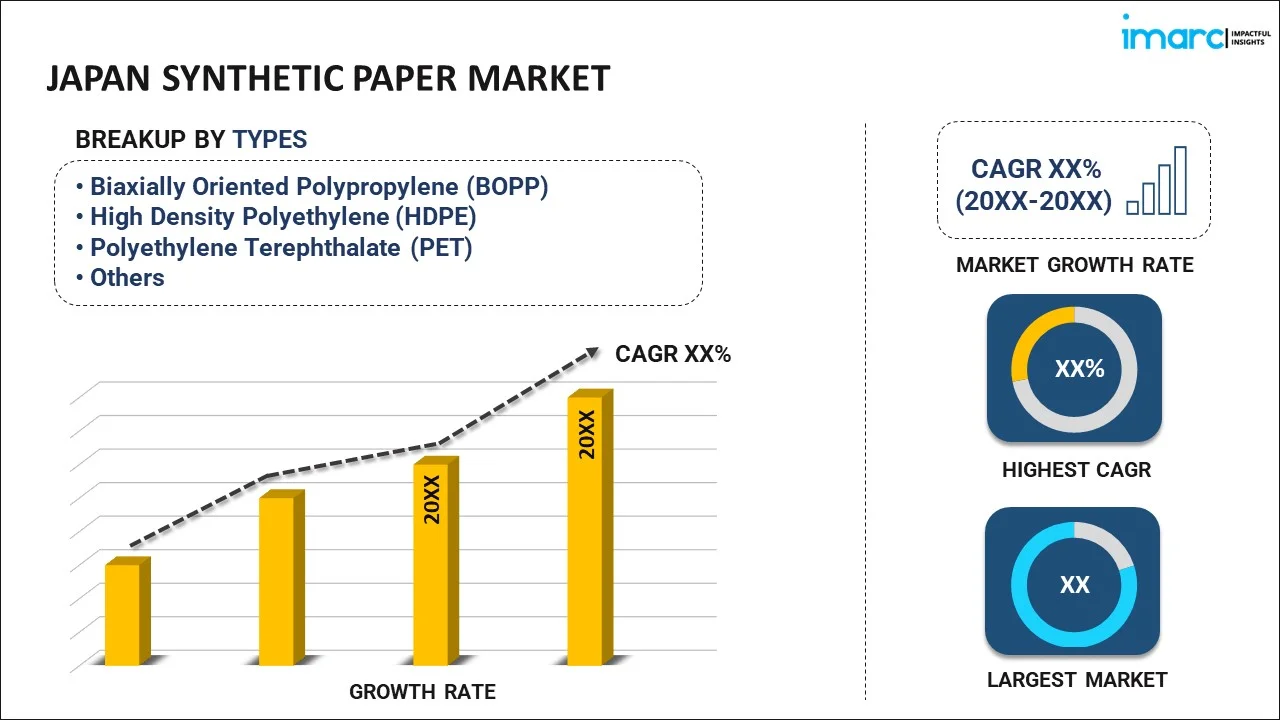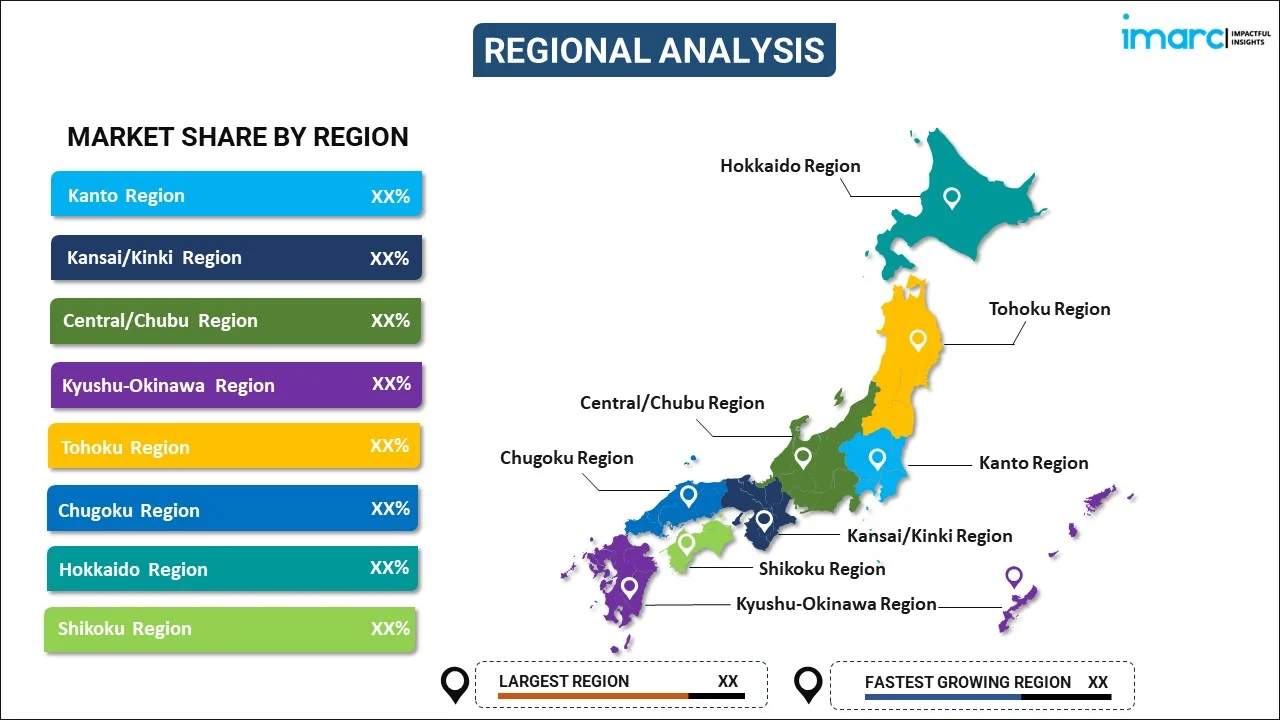
Japan Synthetic Paper Market Report by Type (Biaxially Oriented Polypropylene (BOPP), High Density Polyethylene (HDPE), Polyethylene Terephthalate (PET), and Others), Application (Label, Non-Label), End Use Industry (Industrial, Institutional, Commercial/Retail), and Region 2025-2033
Market Overview:
Japan synthetic paper market size reached USD 63.6 Million in 2024. Looking forward, IMARC Group expects the market to reach USD 125.9 Million by 2033, exhibiting a growth rate (CAGR) of 7.9% during 2025-2033. The market is experiencing growth due to several key factors, including a growing demand for the product within the food and beverage (F&B) industry, heightened consumer awareness regarding the advantages of the product, and the implementation of sustainable manufacturing methods.
|
Report Attribute
|
Key Statistics
|
|---|---|
|
Base Year
|
2024 |
|
Forecast Years
|
2025-2033
|
|
Historical Years
|
2019-2024
|
| Market Size in 2024 | USD 63.6 Million |
| Market Forecast in 2033 | USD 125.9 Million |
| Market Growth Rate (2025-2033) | 7.9% |
Synthetic paper is a product known for its white and opaque characteristics, primarily utilized in printing, packaging, and labeling applications. It is produced using a range of petroleum-derived raw materials, including biaxially oriented polypropylene (BOPP), high-density polyethylene (HDPE), polyethylene terephthalate (PET), polyamide, polystyrene (PS), and polyvinyl chloride (PVC). The manufacturing process involves biaxial stretching film, surface coating, and surface treatment techniques. This type of paper finds extensive use in various applications such as printing identification cards, restaurant menus, passports, charts, books, maps, mark sheets, banners, and a variety of tags. Synthetic paper is recognized for its remarkable durability, offering dimensional stability, ease of printing, and impressive tensile and tear strength. Despite its synthetic nature, it closely resembles regular paper in appearance and texture. Additionally, it exhibits resistance to water, oil, grease, and chemicals, enhancing its versatility. As a result, synthetic paper is widely employed across a range of industries, including food and beverage (F&B), cosmetics, healthcare, chemicals, and packaging, due to its ability to meet diverse requirements and provide durability in challenging environments.
Japan Synthetic Paper Market Trends:
The Japan synthetic paper market is experiencing substantial growth, driven by several pivotal factors that align with the changing dynamics of various industries. A primary driver is the increasing demand for synthetic paper within the food and beverage (F&B) sector. This paper type is extensively employed in the packaging, labeling, and wrapping of various F&B products, including sandwiches, burgers, snacks, and frozen items. Its durability and resistance to water, oil, and tearing make it a preferred choice for F&B applications. Furthermore, heightened consumer awareness regarding the multiple benefits of synthetic paper is contributing to market growth. Moreover, the introduction of eco-friendly synthetic paper produced using sustainable processes and recycled raw materials, such as HDPE, is positively influencing market growth. This eco-conscious approach reduces waste and preserves water resources, aligning with environmental concerns. Several other factors, including the use of synthetic paper in advertising, government regulations promoting recycled and reusable papers, and growing environmental awareness regarding pulp paper usage, are anticipated to drive the Japan synthetic paper market further, underscoring its relevance across diverse industries, over the forecasted period.
Japan Synthetic Paper Market Segmentation:
IMARC Group provides an analysis of the key trends in each segment of the market, along with forecasts at the country level for 2025-2033. Our report has categorized the market based on type, application, and end use industry.
Type Insights:

- Biaxially Oriented Polypropylene (BOPP)
- High Density Polyethylene (HDPE)
- Polyethylene Terephthalate (PET)
- Others
The report has provided a detailed breakup and analysis of the market based on the type. This includes biaxially oriented polypropylene (BOPP), high density polyethylene (HDPE), polyethylene terephthalate (PET), and others.
Application Insights:
- Label
- Hand Tags
- Medical Tags
- Others
- Non-Label
- Packaging
- Documents
- Others
A detailed breakup and analysis of the market based on the application have also been provided in the report. This includes label (hand tags, medical tags, and others) and non-label (packaging, documents, and others).
End Use Industry Insights:
- Industrial
- Institutional
- Commercial/Retail
The report has provided a detailed breakup and analysis of the market based on the end use industry. This includes industrial, institutional, and commercial/retail.
Regional Insights:

- Kanto Region
- Kansai/Kinki Region
- Central/ Chubu Region
- Kyushu-Okinawa Region
- Tohoku Region
- Chugoku Region
- Hokkaido Region
- Shikoku Region
The report has also provided a comprehensive analysis of all the major regional markets, which include Kanto Region, Kansai/Kinki Region, Central/ Chubu Region, Kyushu-Okinawa Region, Tohoku Region, Chugoku Region, Hokkaido Region, and Shikoku Region.
Competitive Landscape:
The market research report has also provided a comprehensive analysis of the competitive landscape in the market. Competitive analysis such as market structure, key player positioning, top winning strategies, competitive dashboard, and company evaluation quadrant has been covered in the report. Also, detailed profiles of all major companies have been provided. Some of the key players include:
- Cosmo Films Japan LLC
- Toyobo Co. Ltd.
- Yupo Corporation
(Please note that this is only a partial list of the key players, and the complete list is provided in the report.)
Japan Synthetic Paper Market Report Coverage:
| Report Features | Details |
|---|---|
| Base Year of the Analysis | 2024 |
| Historical Period | 2019-2024 |
| Forecast Period | 2025-2033 |
| Units | Million USD |
| Scope of the Report | Exploration of Historical and Forecast Trends, Industry Catalysts and Challenges, Segment-Wise Historical and Predictive Market Assessment:
|
| Types Covered | Biaxially Oriented Polypropylene (BOPP), High Density Polyethylene (HDPE), Polyethylene Terephthalate (PET), Others |
| Applications Covered |
|
| End Use Industries Covered | Industrial, Institutional, Commercial/Retail |
| Regions Covered | Kanto Region, Kansai/Kinki Region, Central/ Chubu Region, Kyushu-Okinawa Region, Tohoku Region, Chugoku Region, Hokkaido Region, Shikoku Region |
| Companies Covered | Cosmo Films Japan LLC, Toyobo Co. Ltd., Yupo Corporation, etc. |
| Customization Scope | 10% Free Customization |
| Post-Sale Analyst Support | 10-12 Weeks |
| Delivery Format | PDF and Excel through Email (We can also provide the editable version of the report in PPT/Word format on special request) |
Key Questions Answered in This Report:
- How has the Japan synthetic paper market performed so far and how will it perform in the coming years?
- What has been the impact of COVID-19 on the Japan synthetic paper market?
- What is the breakup of the Japan synthetic paper market on the basis of type?
- What is the breakup of the Japan synthetic paper market on the basis of application?
- What is the breakup of the Japan synthetic paper market on the basis of end use industry?
- What are the various stages in the value chain of the Japan synthetic paper market?
- What are the key driving factors and challenges in the Japan synthetic paper?
- What is the structure of the Japan synthetic paper market and who are the key players?
- What is the degree of competition in the Japan synthetic paper market?
Key Benefits for Stakeholders:
- IMARC’s industry report offers a comprehensive quantitative analysis of various market segments, historical and current market trends, market forecasts, and dynamics of the Japan synthetic paper market from 2019-2033.
- The research report provides the latest information on the market drivers, challenges, and opportunities in the Japan synthetic paper market.
- Porter's five forces analysis assist stakeholders in assessing the impact of new entrants, competitive rivalry, supplier power, buyer power, and the threat of substitution. It helps stakeholders to analyze the level of competition within the Japan synthetic paper industry and its attractiveness.
- Competitive landscape allows stakeholders to understand their competitive environment and provides an insight into the current positions of key players in the market.
Need more help?
- Speak to our experienced analysts for insights on the current market scenarios.
- Include additional segments and countries to customize the report as per your requirement.
- Gain an unparalleled competitive advantage in your domain by understanding how to utilize the report and positively impacting your operations and revenue.
- For further assistance, please connect with our analysts.
 Inquire Before Buying
Inquire Before Buying
 Speak to an Analyst
Speak to an Analyst
 Request Brochure
Request Brochure
 Request Customization
Request Customization




.webp)




.webp)












